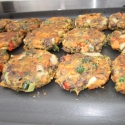Sweet Potato Black Bean Burgers

Prep Time
20 minutes
Prep Notes
Entree, apps or on hand in the freezer - this one's a winner!
Cooking Time
9 minutes
Yields
16 people
Ingredients
15 oz black beans, soaked, cooked, drained, rinsed
3 cups cubed sweet potato, steamed with skin on
2 large leaves kale, removed from stem, chopped finely
½ red pepper, diced and sautéed until tender
2/3 cup finely chopped onion, sautéed until caramelized (1/2 medium onion)
1/2 cup cooked quinoa
6 Tbsp. rolled oats (gluten-free), partially ground
3cloves garlic, peeled and minced
2 Tbsp. sunflower seeds(optional)
1 Tbsp. dulse sea veggie, flakes
½ - 1 jalapeno pepper, halved, seeded and finely chopped (optional)
1/2 tsp. salt •black pepper, freshly ground
1 tsp. cumin
3 Tbsp. fresh oregano, finely chopped
1/4 tsp. coriander
1 tsp. chili powder
1/4 tsp. cayenne (optional)
1 Tbsp. olive oil Yield: 8 large patties, or 16 smaller
Directions
- Mash half of the beans in a bowl.
- Add in the rest of the beans and give a very light stir/mash to combine.
- In a large bowl, mash the steamed sweet potato. Each cube should be mashed, but not too much.
- Stir in the salt, pepper, oregano, coriander, chili powder, cayenne and olive oil, until combined.
- Mix in the red pepper, onion, garlic, remaining black beans, quinoa, sunflower seeds, dulse and ground oats, until just combined.
- Taste, and adjust seasonings to your liking.
- Form into balls, between your hands and flatten into 1/2”-3/4” thick patties. This should make 8 medium/large patties or 16 smaller ones.
- Place on a pan lined with parchment paper and chill.
- Heat cast iron griddle with 1 tsp. olive oil. Place patties on griddle and heat until crispy on first side, then turn, until heated through and both sides crisp.
- Remove from skillet and serve!
*If you want to refrigerate or freeze them, let fully cool on a cooling rack. Place in a sealed container for the fridge, or wrap in saran, then foil, then in a bag for the freezer. If reheating a frozen burger, let it thaw completely. Re-heat in a greased pan, over medium heat for ~3-5min per side, until hot throughout.
*Instead of ground oats, feel free to sub – millet flour, oat flour, quinoa flour, whole wheat flour, etc.
Notes
Cookware through the years has seen many changes…yet, it seems to me that the best has been around a long time. What we cook our food in matters. We seek alternatives to toxic non-stick cookware and alternatives to aluminum. Stainless steel, which seems to be the healthiest alternative but is expensive, and it doesn’t lend itself well to cooking eggs, pancakes and other dishes that non-stick cookware typically excels at. I encourage you to reach way back in the drawer, or to look in the basement or garage for your long lost cast iron skillet and Dutch oven. Let them be your workhorse – they’re also an easy clean up! Discover the benefits of cast iron cooking!
Top Ten Reasons to Use a Cast Iron Skillet
1. Replacing a non-stick skillet with a cast iron one allows you to avoid the toxic fumes that accompany most non-stick cookware. Cast iron can also replace aluminum cookware, which may also pose health hazards.
2. Besides the stove, you can use a cast iron skillet in the oven, at any temperature. This comes in handy for making everything from corn bread, to frittatas and flat bread – or simply roasting root vegetables.
3. It is nonstick. Surprisingly, a preheated cast iron skillet rivals the qualities of non-stick cookware, as long as it is properly seasoned and cared for. You can quickly move up this short learning curve by talking with your local Boy Scouts, or by reading a book or internet article about cast iron care.
4. Cast iron is easy to clean up. Not only does food easily lift off from cast iron cookware, soap is not needed or recommended, since it erodes the seasoning.
5. There are health benefits. You can actually boost your iron intake from eating food cooked in cast iron cookware. This vital mineral is crucial for maintaining energy levels, and it helps strengthen immune systems.
6. It is inexpensive. Cooks looking to replace non-stick cookware often investigate stainless. However, a high-end, 12-inch stainless skillet runs well over $100, while a similar-sized cast iron one costs less than $30. Look for affordable used cast iron at tag sales and antique stores.
7. Food cooks beautifully. Using a cast iron skillet you can create restaurant-quality, homemade fish sticks, potato pancakes and French toast, complete with golden brown, crispy exteriors. Contrast this with non-stick cookware, which makes browning nearly impossible.
8. Cast iron is sturdy and wears well. Since it does not scratch, there is no need to use plastic utensils, and there is no fear of using your silverware to stir or scoop. Cast iron lasts forever! Many people still use cast iron cookware inherited from their parents and grandparents.
9. In an emergency, cast iron cookware can be used over any heat source. As such, many disaster planning lists include cast iron as the survival cookware of choice.
10. It has been used for thousands of years. Natural News readers already understand how new technologies are often the least healthy, while those used by earlier generations are often more beneficial and more in line with how we are designed. Our cookware choice is no exception.
Although there are many benefits to cast iron cooking, make sure to understand the drawbacks before you start: cast iron pans are very heavy; they require intentional maintenance in order to keep them rust-free and non-stick; and care is needed if you have a glass-top stove. But once you take the plunge, you will wonder why it took you so long to start!